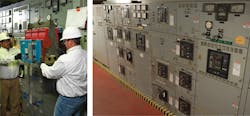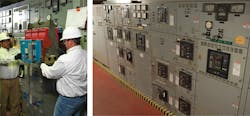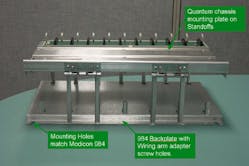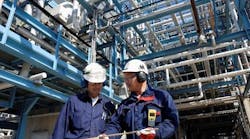Perhaps you were there when your facility’s power distribution, motor control, and automation systems were installed. Perhaps it was before your time. Either way, there is a good chance that when these systems were installed, there was little-to-no thought on how to update or migrate to modern systems.
Many system operators are looking at a facility that has not been updated in 10, 15, 20 or more years. Logic would say it’s only a matter of time until obsolence or age will lead to a decrease in reliability. However, shutting down the facility to install an entirely new system is just not an option. When faced with this issue, many systems operators feel like they have been presented with an impossible choice – secure funds and disrupt production or continue to use the system and hope it remains in service for the foreseeable future.
What may surprise you is that an all-or-nothing approach is not the only option. Manufacturers have developed several different methods for updating power, motor control, and automation equipment. These new methods can make updating more affordable and faster.
Update Service Provider
Updating electrical, motor control, and automation systems can present several challenges. The success of the update will greatly depend on the Update Service Provider. Update Service Providers can be the manufacturer of the equipment itself, an electrical contractor, systems integrator, or other company. Updating these existing systems, however, can be tricky. Some providers may be qualified for only part of the task, while others can do the whole job. Deciding whether to use one firm or multiple firms can be decided on a case-by-case basis, but all considerations should be made based on these points of qualification:
• Industry expertise: Each industry can handle shutdowns differently. For instance, a water or wastewater facility can only handle outages that are a few minutes to hours long. These kinds of plants cannot be off line for days. Knowledge of this dynamic will help the provider divide up the task. There is nothing worse than learning your production has been impacted when you are halfway through an update.
• Project dynamics: The provider should know the dynamics of the project. Some projects may have funds that are a part of a larger project. Other projects may have to fit within the maintenance budget. Some will need to rely on energy and maintenance savings to provide the funding. A well-qualified provider will understand these dynamics and have solutions for each.
• Look beyond the obvious: Some field conditions may make updating impossible. Sometimes, these are discovered only after the update has started. Look for a provider that understands to look beyond the obvious. Some things to look for are corrosion, dangerous conditions, and a phenomenon called whiskers.
• Brand independence: It might be tempting to use the original equipment provider for the update. Some providers, however, are capable of servicing all manufacturers’ equipment. This allows for a more competitive environment.
• Financial strength: A good update should make a system more reliable. But, if an unforeseen event occurs, you want an Update Service Provider that has resources to mobilize emergency replacement equipment and provide other possible reparations.
Switchgear
Switchgear is at the heart of the power distribution system. If this has to be updated, then everything downstream has to be shut off. This could include stand-alone control panels, motor control systems, lighting, HVAC, and other systems. Thus, updating these systems needs to be done very carefully.
Switchgear, like everything else, has advanced over the years. Today’s transfer switches or breaker switching schemes are controlled by programmable logic controllers (PLCs). Furthermore, today’s new arc flash requirements may have an impact on how an update is managed.
As an update of switchgear is being conducted, space needs to be considered. Today’s components can often decrease space requirements. It may be tempting to then use smaller sections, and make the gear more compact. However, if the conduit stubs up through the floor, then the cost of concrete removal and rewiring may offset the advantages. Also, any change to existing wiring creates an opportunity for errors.
Another factor to consider is how the update is to be staged. If parts of the update can be done individually, then funding via the maintenance budget is an option.
Finally, most switchgear updates are done to eliminate old or obsolete components, but switchgear updates can also lower energy costs, and provide more data on facility operation. This can enhance maintenance and provide a better view of events.
Motor Control Centers
Motor Control Center (MCC) updates strongly resemble switchgear updates. On both of these, conduit placement is an issue. Both also offer opportunities to use the maintenance budget or another alternative form of financing.
With an MCC, the buckets are designed to be removed and replaced easily. This allows for a very fast update, assuming the frame and buss are in good shape. Since bucket replacement is easy, it is possible for an Update Service Provider to offer buckets for many different brands of MCC.
An MCC offers a greater chance to save energy than a piece of switchgear. This is because Variable Frequency Drives (VFD) can be housed in an MCC. The magic of VFDs is their ability to utilize the Affinity Laws. According to these laws, decreasing a pump’s speed by 20 percent will result in a 50 percent energy savings. When you consider that 40 percent of the total pump’s lifecycle cost is from energy , the impact of the Affinity Laws is huge.
SCADA Systems
SCADA is very different from switchgear or MCCs. While many think of it as just the computer hardware and software, SCADA systems are really the operator interface terminal software, the computers and servers the software runs on, and the automation system that exchanges data with the software.
SCADA updates occur for a variety of reasons, including:
- Software that is not compatible with the hardware
- Software that is running erratically
- Software that is no longer supported by the supplier
- Deteriorated relationship with supplier
- Inability to handle new data points
Today’s SCADA systems predominantly run on PC-based technology and servers. Thus, from a hardware standpoint they are not hard to update. From a software standpoint, it is slightly more challenging. Perhaps the toughest part is the actual application. Traditionally, moving from one system to another requires a complete manual rebuild of the SCADA. This, of course, results in retesting each point. Now some Update Service Providers can offer the use of conversion tools. These software-based conversion tools can automatically convert about 90-95 percent of the application. While it does not eliminate all of the work, these tools significantly reduce the time needed to perform the conversion, ultimately saving money. Considerations when updating a SCADA system include:
-
Software conversion tool: As mentioned above, saves time, money, and decreases errors.
-
Detail desired performance levels: Outline the performance expected from an updated SCADA. This should include an I/O update rate, trending and data storage requirements, where the data should be stored (i.e., SQL Database), accessibility of data from external software (i.e., spreadsheet program). The more detailed, the easier it is to judge specific packages.
-
Ensure that future data analysis is better than current: Properly outlined expected performance levels should address this. Data analysis is so critical, however, that a second reminder is in order.
-
Cost of Ownership: SCADA is not just a one-time software purchase. Some suppliers require support contracts for updates and technical help and also charge for development licenses, technical training, or for updates. Look at all of these other costs of ownership during the decision process.
-
Update record: Remember that updating a SCADA system may be a challenge that will be faced again in the future. Examine prospective SCADA suppliers’ update philosophy and success record. This will provide a decent idea of possible future challenges, and also show a supplier’s commitment to the SCADA marketplace. Only accept those that can show a clear path of update with less than one second of downtime.
-
Maximum size of project: Many facilities are dynamic environments that are subject to change and expansion. Therefore, ask to see the largest projects the supplier has done. Also, look at the performance of those installations and how long they have been in service. A system that can handle today’s needs, but not tomorrow’s, is something to be avoided.
-
Process knowledge: Evaluate what kind of expertise the SCADA supplier has in your market. If the supplier “speaks your language,” then this can make communication easier. Plus, these resources can be used to help tailor your system.
Automation Systems
The SCADA system interfaces with some form of a controller, whether it be a programmable logic controller (PLC) or distributed control system (DCS). These controllers, their input and output racks, and associated networks comprise the automation system.
In most cases, the automation system actually performs the control of the facility. Thus, updating these can be a challenge. This system has many of the same dynamics of power equipment, with the same software challenges of a SCADA.
To handle these dynamics, some automation system suppliers have developed software conversion tools, and different scenarios. Basically, these scenarios break down into three categories.
The first category is called complete updating – these are the traditional scenarios where everything is updated at once. This requires all the funds to be produced at one time, and also requires a time for the system to be down. This is done usually as part of a larger project. The second scenario is called a partial update – this occurs when only a part of the automation system is updated. Since only a part of the updating is being done, the cost is lowered. Sometimes the maintenance budget can be used for this. The third scenario, called phased, is a combination of the previous two. The intent is to do a complete migration; however, it will be done in phases. The first phase usually involves the processors, and the remaining phases the inputs and outputs. With a phased migration, the maintenance budget, project funds, or a combination of the two can be used.
The challenge with an automation system update is the footprint within the control cabinet. Not all controllers have the same footprint. Thus, changing a PLC can change the footprint requirements. Also, the wiring arms between the two controllers will be different. If traditional methods are used, then the panel has to be re-drilled and rewired to accommodate the new controller. This creates an expense, and the panel has to be down during retrofit. Often, it will be easier to replace the panel entirely.
Today, some automation suppliers have developed kits to address these issues. The kit usually contains a backplate that can mount in the old controllers’ holes. This prevents the need for re-drilling. The kit then comes with wiring block adaptors that adapt the old controllers wiring arms to the new controllers’ modules. This eliminates the need to rewire. Finally, the kit will come with a mounting plate for the new controller. In the well designed kits, the backplate plate, wiring arms, mounting plate, and new controller will fit within the space of the original controller. When using these kits, installation can be done in as little as fifteen minutes.
When updating, many people think of a complete removal of existing equipment, and therefore, tons of money; however, technologies have been developed that can prevent or mitigate possible issues. To minimize challenges associated with an update, first decide how the migration will be accomplished, will it be done at once or over time. Then decide how it will be funded. Finally, research your options and select an Update Service Provider. Once updated, the equipment should serve for years to come.
Grant Van Hemert, P.E., is a water wastewater applications specialist for the Schneider Electric Water and Wastewater Competency Center. He has 15 years experience in water and wastewater automation and another five years in automation and control engineering. He is a registered P.E. in the state of North Carolina and is the chairperson for the AWWA Instrumentation and Control Committee. Mr. Van Hemert can be reached at 919 217-6367 or [email protected].
Reference
1. Hydraulic Institute, Optimizing Pumping Systems: A Guide For Improved Energy Efficiency, Reliability, And Profitability




